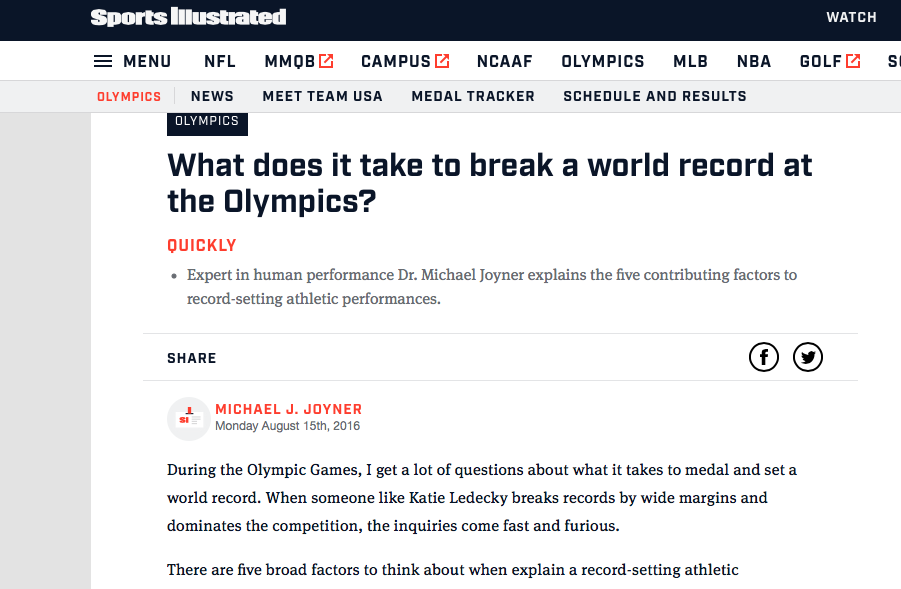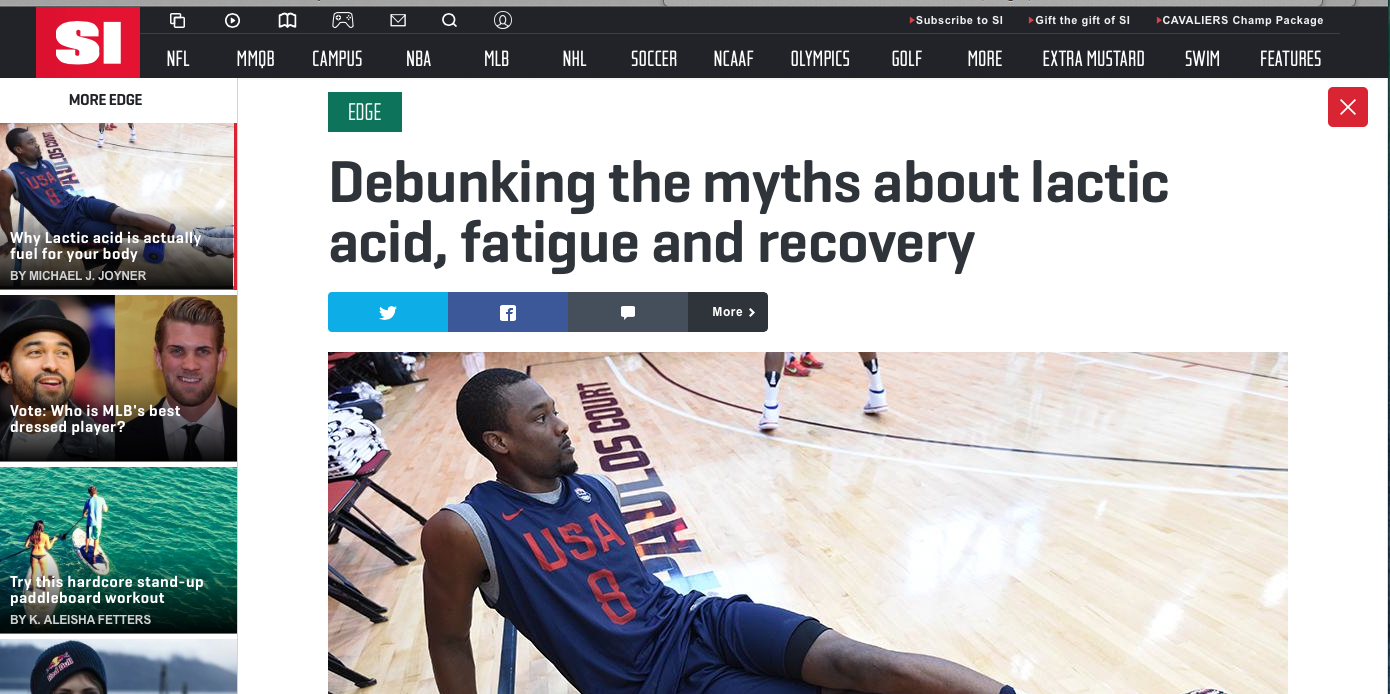Archive for the ‘Current Events’ Category
Bring Back The 3 Hour Marathon!
The big marathon news the last few months has been the Nike Breaking2 effort that culminated in Eluid Kipchoge running a 2:00:25 marathon exhibition last May. As a result of my long time interest in the 2 hour marathon, I got a lot of media questions about this effort and what is next. One of the more interesting subtexts of these questions was the chats I had with some of the writers and reporters I visited with.
A lot of these folks told me they were runners who had done marathons in middle three to four hour range. As the conversations progressed most of them wanted to go faster and were interested in tips about how that might happen. What follows are some key points I made and questions I asked in these conversations. In future posts I am going zero in and take a deep dive on some practical advice to help people go faster, but first an overview.
1. Times used to be a lot faster. My friend and 1968 Boston Champ Amby Burfoot just did a piece on this for the Washington Post based on a “new” study showing times were slowing. In an e-mail exchange on this topic I made the following points
“This is certainly no surprise to people how have followed mass participation running races in the US over the last 2-3 decades and it is clearly reflected in things like the yearly marathon data summary and slower Boston Qualifying times.”
I went on to outline three main reasons for the slower times:
“First, during the original running boom in the later 70s through the middle 80s essentially athletic men and women “read Runner’s World” and emulated the elites in terms of training and racing patterns and all sorts of people with at least some ability were doing relatively high mileage, high intensity training with specific time goals. Second, as things progressed finishing a marathon became as the late Chris Chataway put it a “suburban Everest”, and there was a profusion of marathon training classes that focused on a kinder gentler approach with lower mileage and less intense training – the goal was to finish, not get close to a personal physiological limit. Third, as a result of the kinder gentler approach a much broader range of body types is now doing races and that coupled with increased population body weight is likely contributing to the slower times.
I finished concluded with the following:
“Over the years I have given a number of people who wanted to go faster pretty simple advice, run more, lose weight and do intervals – when followed it works.”
2. Run more races and train for the 10k. In the good old days of the late 70s and early 80s when all sorts of men were breaking 3 hours and many women were running 3:20 or 3:30 people ran the almost weekly 10k, 5 miler, 10 miler, and/or half marathon in their city. There were lots of big and semi-big races and everyone was focused on getting personal records (PRs). Many cities had local grand prix type points systems and yearly club rankings. This sort of racing did lots of things for people but it taught them to push themselves and it ensured that they were getting regular high intensity runs in. People also learned about pacing and had the chance to rub shoulders and talk training with the local “fast people”. The elites of that era were basically 10k runners who were doing a long (15 plus mile) run per week (usually Sundays) to be ready for the marathon. Embedded in this “good old days” narrative are two of my key points “run more and do intervals”. There were also strong local running groups and subcultures. Many places there were “meet on Sunday morning” spots for a long run. One of the most famous was a visitor’s center at Mission Bay in San Diego, and apparently some version still exists! For faster runners these informal “training” sessions sometimes got pretty fast and downright brutal with the last few miles run close to 5 minute pace.
3. Lose Weight. A quick visual inspection shows that all sorts of body types are now doing marathons and endurance sports. For at least some people this is due in part to more strength training. If you are a serious athlete and want to take 10-20 minutes off your marathon time perhaps cut back on heavy weight lifting and switch to push-ups and pull ups. You will be amazed at what dropping 5-15 pounds will do. BMI is a not the world’s best index of body fat, but in the good old days you did not see many people with BMIs over 25 running fast.
Case Report Ed Caesar? Ed is the author of 2-Hours and a recovering big guy rugby player (he is 6’5”). Ed started running more as covered the Breaking2 effort. He lost weight, did intervals and he broke 1:30 for the half marathon. A fine time that bodes well for what I hope is a Breaking 3 effort on his part. He is also a throwback to the 1970s and 80s running boom when as I pointed out at the start of this post when a lot of athletic men and women read Runner’s World and emulated the elites in terms of training and racing patterns and all sorts of people with at least some ability were doing relatively high mileage, high intensity training with specific time goals.
Corporatization & Medicine: Three Cautionary Tales
Medicine is being corporatized and even prestigious academic institutions are not immune. This is a topic that is being discussed by physicians and researchers in coffee rooms and cafeterias at leading hospitals and academic medical centers all over the world. Here are some of the concerns, lessons and tales – along with some recommendations – that I have heard in my travels that might advance this discussion.
Cautionary Tale #1: “Business Leaders” are not clairvoyant, so why are leaders at prestigious medical institutions so enamored with everything corporate and financial types on various oversight boards suggest? The person who asked this question pointed out to me that many big retailers like Best Buy were caught flat footed by the internet and while doing better more recently, they are still struggling with issues like long term growth. Others have pointed out the ethical and judgement issues associated with the accounting, banking and finance scandals of the last 15 years. As an example here is a top 5 list for accounting giant PriceWaterhouseCoopers. Given these sorts of lapses in strategic thinking and ethical judgement why is medicine so anxious to adopt a “business model” approach to the world?
Cautionary Tale #2: What happened at MD Anderson and/or Sweden’s Karolinska Institute can’t happen at my center. Both MD Anderson and the Karolinska Institute have had recent major meltdowns related to a host of ethical, management and leadership issues. The people running these organizations have all essentially been fired or resigned in the last couple of years. While the specifics differ, key common features of both situations include leadership that became disconnected from long standing institutional culture, rank and file clinicians and researchers were marginalized in the decision making process, and leadership sought or developed carve outs from normally rigorous internal oversight mechanisms. It is incumbent on us all to hold leadership’s feet to the fire at our institutions and make sure they don’t lead to full-blown ethical breakdowns. We are all busy, we all worry about retaliation and marginalization, and we all thing our voice matters less than it used to. However this is no time for learned helplessness, and we need to speak up.
Cautionary Tale #3: The people raising concerns are a small minority and merely disgruntled whiners and alarmists – they just don’t understand. This Tale is typically promulgated by members of leadership or various allies in the institutional establishment. It is designed to marginalize and suppress competing views and dissent no matter how constructive or legitimate. The short response to Tale #3 is NASA O Rings and the Challenger disaster, the quagmire in Iraq, and the Banking Crisis of the late 2000s. In each case a few experienced and insightful people issued detailed warnings that might have averted disaster and were ignored or worse as institutional groupthink prevailed.
Please Leaders Remember:
- Corporate leaders and financial bigshots don’t walk on water and don’t be overly impressed by private jets, fame and who says what at Davos. Carefully check their track records and where they have really led their organizations. Many are well paid or well off in spite of being at the helm of huge system failures and failures of vision of a magnitude that should never be tolerated in medicine.
- Repeat after me….. It can happen here, and make sure you have at least a few truth tellers nearby at all times. Read the Emperors’ New Clothes and Animal Farm yearly.
Cultivate dissent and don’t marginalize it. Medicine is full of people looking to get the right answer on the test. Find the people in your organization who can ask the right question and who are not afraid to speak up. My guess is that if you contacted the people responsible for the recent meltdowns at MD Anderson and Karolinska they would tell – that in retrospect – they wished they had paid much more attention to the dissenting voices at their institutions.
You are currently browsing the archives for the Current Events category.







